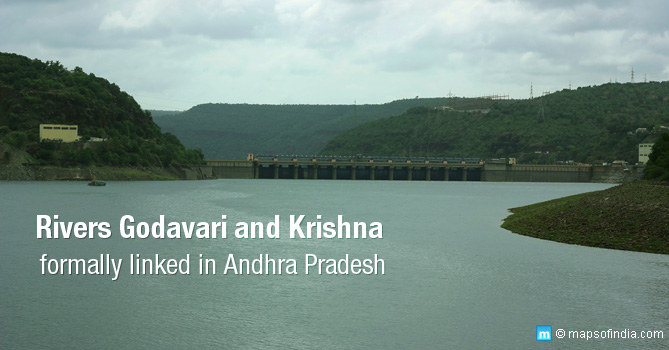The Pattiseema Project
The Pattiseema project, an initiative taken up by the Andhra Pradesh government to link the waters of the state’s two major rivers – Krishna and Godavari – was commissioned on 16 September, 2015. The project aimed at linking the River Godavari and the River Krishna was conceived of in March 2015, the foundation was laid down in May 2015, and an attempt was made to complete it by August 2015. Delays in the implementation required an extra fortnight to commission it. The magnitude of the project can be understood by the fact that the Godavari belt and Rayalseema are divided by a distance of about 500 kilometres, some of it upstream. It is, however, a matter of national pride that the mission is now ready to take off. A 54-kilometre canal linking Godavari and the Polavaram Right Canal was built in record time. On 16 September, the Chief Minister of Andhra Pradesh, Mr. N Chandrababu Naidu, flagged off the project by igniting the pump at Pattiseema, which diverts River Godavari’s water into the Polavaram right main canal. This canal links with the Krishna River and water shall be sent into the Prakasam Barrage in Vijayawada. Andhra Pradesh Irrigation Minister Devineni Uma Maheswara Rao said that there was a pressing need to address the drinking water requirements of the people of the Krishna delta. Another barrage similar to the Prakasam Barrage might be commissioned though there is no official word on this yet.
Rayalseema’s Drought Woes
The major goal of the Andhra Pradesh government in undertaking the Pattiseema Project is to bring relief to the people of the Rayalseema region of Andhra Pradesh. The Rayalseema region is a landlocked bit of land surrounded by Telengana to the north, Tamil Nadu to the south and Karnataka to the west. Traditionally, Rayalseema has been one of the driest drought affected belts in the state. While the northern Godavari valley is a lush green fertile land often referred to as the ‘Granary of India’, the districts of Kurnool, Anantapur, Chittoor and Cuddapah have suffered from failed crops, parched fields and even lack of drinking water.
The Krishna is one of the few rivers that flow from West to East across the Deccan. Originating in the Satara District of Maharashtra, it flows through the states of Karnataka, Telengana and Andhra Pradesh, emptying into the Bay of Bengal near Hamasaladeevi. The Krishna waters were the subject of much dispute between Karnataka and undivided Andhra Pradesh. The 13 million population strong region of Rayalseema has been receiving much lesser rainfall through the decades. The Krishna waters reaching Srisailam (northern fringe of Rayalseema in Kurnool) after bestowing their bounty through the river’s course dwindle in volume and are not adequate to avert a natural catastrophe in the region.
Why Link the Rivers?
The Pattiseema project is likely to bring extensive relief to the people of these districts, collectively called Rayalseema. Each year, the people of Rayalseema wait for the opening of the Srisailam Dam. This water is discharged into the Prakasam Barrage to cater to the south of Andhra Pradesh. Krishna waters are also routed to this region through the Nagarjuna Sagar Dam near the Guntur district.
River Godavari, unlike the River Krishna, is an overflowing river that floods its banks each year. Floods of the Godavari River destroys crops in the Godavari valley and about 3000 TMC (thousand million cubic feet) of water from the river is discharged into the Bay of Bengal. Instead of wasting this freshwater, the government of Andhra Pradesh made plans to link the two rivers by means of the Pattiseema project and utilize the excess water to be supplied to Rayalseema. The region shall no longer need water from the Srisailam Dam for its survival. The Rs. 13,00-crore project aims at bringing 80 TMC of Godavari waters to the River Krishna having travelled about 160 kilometres. This water will service the needs of about seven lakh acres of agricultural and irrigable lands in the south of Andhra Pradesh through the Prakasam Barrage.
The Political Angle
“Andhra Pradesh is making the nation’s dream true by integrating two major rivers”, said CM N Chandrababu Naidu, prior to the launch of the project. The government of Andhra Pradesh’s initiative comes despite staunch opposition from the Indian National Congress. Naidu’s Telugu Desam Party was accused of having made a killing in the project and yet it may not be denied that the completion of such a mass scale project within six months is a grand achievement for the party and the CM.
The Rayalseema region is a politically important region in the new Andhra Pradesh with about 30 percent of the state’s electorate living in these parts. The region has produced over six chief ministers including the incumbent CM. The economic and political importance of the region cannot be undermined.
The Polavaram Project
Another major project linking the River Godavari and the River Krishna is in the works in Andhra Pradesh. “It is a gigantic task, but we will work with double speed and complete the works by March 2018,” promised Andhra Pradesh’s Irrigation Minister Devineni Umamaheswara Rao about the Polavaram project. The project includes construction of a dam at Polavaram and supplying Godavari water to Vijayawada and neighbouring areas.
For decades now, the southern states have been embroiled in water disputes. The division of waters from these rivers has created an atmosphere of much bitterness and mistrust. Given the socio-political conditions, inter-linking of rivers as undertaken by Andhra Pradesh seems to be a wonderful solution to a persistent problem.
The inter-linking of rivers is not a new idea. Earlier in 1952, the project was conceived by the then Prime Minister JL Nehru to link India’s prime rivers – the Ganga, Narmada, Godavari, Krishna and Cauvery. The mammoth civil engineering project had an estimated cost of Rs. 750 crore. The project did not leave the planning table due to resistance from the northern and central states of India. The project was later revived by PM Vajpayee but was shelved by the subsequent UPA government. With the Pattiseema project, however, India has taken another leap forward in supporting its agrarian economy and in becoming self-sufficient in terms of growing its own food.
Read Also:
Godavari River Map
Krishna River Map





